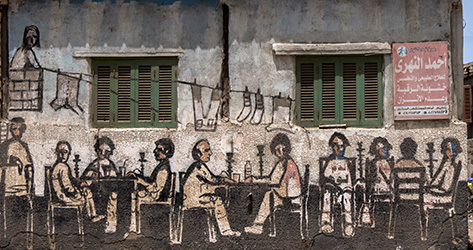- Discover.Zanzibar, the African island of 'hakuna matata' (or be happy)
- Safaris: the ten best natural parks in Africa
The seagulls fly over inland, beyond the promenade and the row of barges that remain stranded next to the piers. Borg el Borolos was a gray town of humble Egyptian fishermen lost in the middle of a tiny peninsula, between the Mediterranean Sea and Lake Borolos. Until dozens of graffiti began to sprout from the walls and colored the streets of the town with colors.
Wandering through its arteries now, between the cafes where natives spend their hours and the stalls offering fresh fish, is a true artistic experience. Endless graffiti has changed the appearance of the wasteland, turned into an open-air museum 300 kilometers north of Cairo. The motifs are diverse and rich: from maritime scenes to pharaonic themes or simple and evocative landscapes.
"They have changed the façade of the town. It is something very beautiful," Yaser Mohamed, a 17-year-old who walks through the adobe and cement houses that are arranged in the front line, faces the calm waters of EL MUNDO. lake. "I work as a fisherman. We leave at 6 in the morning and return at 10. There is no other job in the town," he says.
meeting between artists and fishermen
Every autumn for thirty years, thirty Egyptian and foreign artists have landed in Borg el Borolos and scattered around it, packed with paint and brushes. "It is a town of very humble people who do not have basic public services. We thought that something had to be done for them," says Abdelwahab Abdel el Mohsen, the Egyptian painter who forged the initiative that has revolutionized all corners of the village.
"At first, the inhabitants refused to have their facades painted, but everything changed when they saw the first results," says the artist. "We always do the same thing. The painters come and walk around the town in search of inspiration," he details. A feeling of care for common spaces has begun to emerge from the meeting of artists and fishermen. "It has changed the discipline of citizens. Tons of trash that have remained on public roads have been removed and now they are the ones who are raffling off artists."
"People have received us very well. Some families have even started painting their homes with our paint. Some artists have been born among the neighbors," recalls Ahmed Abdelkarim, who has participated in all the editions held to date. "Our drawings summon friendship and love. All the people are now dedicated to protecting creations. The works provide them with a new horizon," murmurs the artist.
Graffiti has not only provided a renewed aesthetic to the town. They have also brought poetry to a place foreign to the cadence of the verses. On one of the walls there is a mural that recalls the poet Constantine Cavafis , the universal Alexandrine who made the Mediterranean city, today plunged into an implacable decline, its Ithaca. " If you are going to undertake the journey to Ithaca, / ask that your path be long, / rich in experiences, in knowledge, " wrote the Greek.
the battle of borolos
The terroir also contains pieces of the history of the land of the pharaohs. It was in its vicinity that a battalion of the Egyptian army thwarted the incursion of European troops in 1956, after the ardent warrior that sparked the nationalization of the Suez Canal . "Here the battle of Borolos was fought, when French and English warships tried to invade the country," summarizes Iman Ezzat, a teacher and another of the souls of the project that is transforming the canvas of the town.
Ali Sameh, who runs a laundry in the corniche , a Tunisian artist scribbled the facade of her business two years ago. A crucible now inhabits where before there was only cement. "I am happy. He drew fish, boats and mosques . He is striking and he had total freedom to choose the subject," argues the small businessman outside the premises.
During the last decades, before art flooded its geography, Borg el Borolos was the exit door for the barges that - crowded with Egyptians and refugees from the African continent - left for the Italian coast. Restrictions imposed by the local army have stifled the migratory flow. On one of the walls, color is accompanied by a concise and direct phrase as a wish: "Hope will be born tomorrow and life will open its doors."
How to get
Borg el Borolos is a three and a half hour drive from Cairo. The best option is to take the road that connects the capital with the cities of Tanta and Kafr el Sheikh. Another alternative is to arrive from Alexandria, one and an hour down the coast road.
According to the criteria of The Trust Project
Know more- tourism
- Egypt
GetawayBerlin, the greenest capital in Europe that bets everything on green
Tips Am I entitled to a refund? How airlines and hotels work against the coronavirus
NatureThe largest cave in the world occupies a 40-storey building and ... continues to grow

